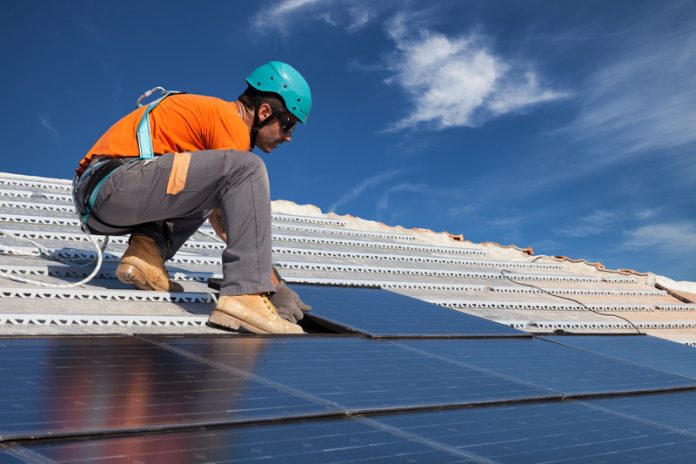Improving energy efficiency in social housing can be achieved with solar devices. PassivSystems outlines how this technology is being utilised in Stirling
In pursuing their efforts to address fuel poverty, many social housing landlords face some unique challenges in tackling the pressures to keep rental and energy costs as low as possible while complying with increasingly stringent energy efficiency standards.
Stirling Council is a case in point. Scotland has introduced higher energy efficiency standards – the Energy Efficiency Standard for Social Housing (EESSH), to which social landlords must comply by 2020.
“Solar PV is the only viable technology that will get us over the pass mark,” said Gregor Wightman, Property & Private Sector Housing Manager at Stirling Council. “Our aim is to roll out solar PV to as many properties as possible – although we are limited by the challenges we face, mixed tenure tenements and stock located within Conservation Areas.”
Stirling has already installed over 1,500 systems, giving it a portfolio of almost 4.8 MW to manage. The council is planning to install PV to another 2,000 of its properties, funding the project by supplementing its Solar PV Capital Investment budget with the feed-in tariff (FIT) payments it receives. Residents who have solar arrays on their properties save around £270 per year, with solar switch devices being installed in off-gas areas and battery storage being trialled in a number of properties.
Minimising downtime
Stirling Council launched its solar programme in 2012, and was clear at the outset that it would need to implement remote monitoring to maximise returns and minimise maintenance costs. It is crucial that the solar arrays work at peak efficiency to recoup the council’s expenditure. From the outset of the solar PV programme, its appointed contractor at the time recommended PassivSystems’ products and services, and Stirling has used its smart meters and associated services on all installations since then.
“We depend on the PassivPro service to alert us to when a PV array goes offline so that we can fix problems with a minimum of downtime. Using its automated metering facility removes the cost of having to send staff to each property every 3 months to get a meter reading,” continued Gregor. “We also depend on the automated weekly reports we generate to verify that individual systems are performing to our expectations and with the use of PassivPro Dual Element Generation Meters, we can also remotely monitor the self-consumption rates in each property.”
As a result of using automated monitoring, Stirling Council now includes response times in the service levels it agrees with its O&M partners.
Advanced metering
PassivSystems offers Stirling a choice of meters, with its latest dual element meter able to measure the power generated and how much energy is exported and calculate on-site consumption.
Using the dual element meter – predominantly on its new properties, allows Stirling to provide feedback to their tenants about self-consumption levels and can aim to maximise their benefit from the free solar power they receive.
Because of the wiring implications, Stirling can’t physically fit the dual element meters to some of its older properties – there simply isn’t enough wiring room within the distribution board.
“As a social housing provider we’re more accountable than private housing developers,” stated Gregor. “Having accurate information from the smart meters enables us to report back to our tenants and explain how they are benefiting from our solar investment – that’s a significant benefit to us.”
FIT Automation Services
Stirling Council has also benefitted from the Feed-in-Tariff automation services delivered by PassivSystems and sister company, and FIT Licensee, arto.energy Limited.
The benefits of the service were clear from the beginning to Stirling Council. It enables both a simplified cloud-based registration process for new solar PV installations and fully automated quarterly FIT meter read submissions for their entire portfolio.
The results – a significant reduction in workload by alleviating the administration of managing FIT claims and registering new systems have been quite tangible. Managing multiple FIT licensees, read submission dates, read failure resolution and financial reconciliations was taking a significant amount of time and resource each month; switching to arto.energy has almost eliminated this burden.
The system ensures that copies of all documentation for new registrations are stored securely and are verified. Furthermore, meter reads are submitted completely automatically without the need for intervention from the council each quarter. Potential failed reads are communicated to the council for remedial works. This ensures that at the end of each quarterly levelisation period, the maximum FIT revenue can be claimed.
Measurable results
Solar PV incorporates inherently reliable technology – systems rarely break down. Where automated monitoring really helps is in identifying issues brought about by tenants. Common faults include tenants letting their pre-payment meters run out, or not re-setting trip switches after a circuit fault, or sometimes turning off the isolator switch in error.
“As a result of using PassivSystems’ platform we’re probably getting another 5% out of our whole portfolio,” claimed Gregor. “That’s a financial benefit on top of the cost savings we get from automating the meter reading and streamlining the FIT process.”
“Investing in these technologies and services is essential if we are to get the best out of our microgeneration portfolio. It also gives us a platform to develop new approaches in the future. For example, going to market with a power-purchase agreement model where we forego the diminishing FIT and instead sell power back to the grid on the open market.”
About Stirling Council
Stirling Council has over 5,600 social housing properties of which 7% are located in rural areas with no access to the gas network.
PassivSystems











